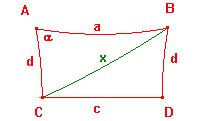Suppose that the hyperbolic saccheri quadrilateral S has base of length c,
summit of length a and sides of length d. Then the summit angle α and the
hyperbolic area S are determined by the formulae :
(1) cos(α) = sinh(d)sinh(½c)/cosh(½a)
(2) sin(α) = cosh(½c)/cosh(½a),
(3) tan(½S) = sinh(d)tanh(½c)

The sketch shows the quadrilateral labelled so that the base is CD and
the summit is AB. The summit angle is α. We have drawn the diagonal
BC of hyperbolic length x.
(b) sinh(½a) = cosh(d)sinh(½c).
(c) cosh(t) = 2sinh2(½t)+1,
(d) cosh2(t)-sinh2(t) = 1,
(e) sinh(t) = 2 sinh(½t)cosh(½t).
saccheri theorem
hyperbolic identities
Using (a), cos(α) = cosh(d)(cosh(a)-cosh(c))/sinh(a)sinh(d)
Using (c) for cosh(a) and cosh(c), we get
cos(α) = cosh(d)(sinh2(½a))-sinh2(½c))/sinh(a)sinh(d)
Using (b) and (d), we get
cos(α) = cosh(d)sinh(d)sinh2(½a)/sinh(a)
Using (b) and (e), we get
cos(α) = sinh(d)sinh(½c)/cosh(½a)
sin2(α) = 1 - sinh2(d)sinh2(½c)/cosh2(½a)
= (cosh2(½a) - sinh2(d)sinh2(½c))/cosh2(½a)
= (1+sinh2(½a) - sinh2(d)sinh2(½c))/cosh2(½a)
= (1+ cosh2(d)sinh2(½c) - sinh2(d)sinh2(½c))/cosh2(½a)
= (1+sinh2(½c))/cosh2(½a)
= (cosh2(½c))/cosh2(½a)
Now cos(α) > 0, so α is acute, and so sin(α) > 0. Thus,
sin(α) = cosh(½c)/cosh(½a).
quadrilaterals shows that S = 2π - (sum of angles of ABDC), so
S = π-2α, and hence ½S = ½π-α.
It follows that tan(½S) = cot(α). Thus (3) follows from (1) and (2).
This determines S since ½S is in (0,½π).